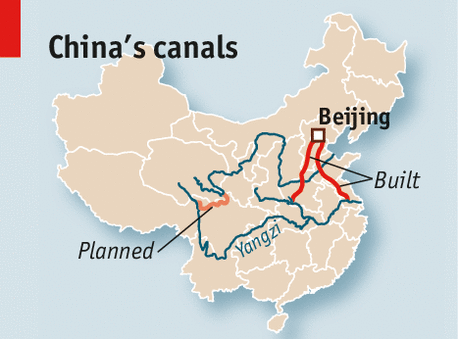Vast new waterways will not solve China's desperatewater shortages
Soon the centrepiece of one of China's mostspectacular engineering projects will be completed, with the opening ofsluicegates into a canal stretching over 1,200km(750 miles) from the Yangzi river north to the capital, Beijing. The newchannel is only part of the world's biggest water-diversion scheme. More than300,000 people have been kicked out to make way for the channel and theexpansion of a reservoir in central China that will feed it. But the governmentis in a hurry, and has paid their complaints little heed.

China's leaders see the so-called South-North WaterDiversion Project, which has already cost tens of billions of dollars, ascrucial to solving a water problem that threatens the country's development andstability (see article). Grain-growing areas around Beijing have about as much water perperson as such arid countries as Niger and Eritrea. Overuse has causedthousands of rivers to disappear. The amount of water available is diminishingfast as the water table drops and rivers dry up; what little is left is oftentoo polluted even for industrial use. The World Bank has said that China'swater crisis costs the country more than 2% of GDP, mostly because of damage tohealth. The new supply's arrival in Beijing will thus come as a huge relief toofficials. Indeed, so desperate is the lack of water that some have in the pastsuggested such drastic answers as moving the capital.
Yet China's water problem will remain unsolved. Thecanal is the second leg of the diversion project; the first, which opened lastyear in eastern China, brings water from the south along the route of the oldGrand Canal, built 1,400 years ago, to the northern plain. Neither will provemore than temporary palliatives as demand continues to soar and pollutionremains widespread. China's water crisis cannot be tackled by showymega-projects. Misguided policy is as much to blame as a mismatch in supplybetween the water-rich south and the arid north. A new approach to watermanagement, rather than more concrete, is needed.
Send them the bill
The solution is simple: China needs to price itswater properly. Prices have risen a bit recently, but even in places wherewater is scarce it is ridiculously cheap, and as a result there is colossalwaste. Beijing is ringed with water-hungry golf courses for the elite.Householders are scarcely aware that water has a value. Planners fail to takethe cost of water into account, so provincial governments enticewater-intensive firms to invest in desert areas and officials designatedrought-prone regions as the sites of vast new cities. Raising the price ofwater in places where it is in short supply would discourage investment in suchareas.
The Maoist obsession with food self-sufficiencycompounds the problem. The arid northern plain, home to 200m people, produces water-hungry crops such as wheatand corn. Nearly 70% of water consumed in the area is used for agriculture. Itis time for China to abandon autarkic thinking and import more food.
Last year the Communist Party pledged to let marketforces play a decisive role in allocating resources such as water, land andelectricity. If it did so in the case of water, it would reap many benefits.Development would become more environmentally friendly, China could devote itscapital and remarkable engineering skills to projects more productive thanshipping water around the country—and everybody would save a great deal ofmoney.












